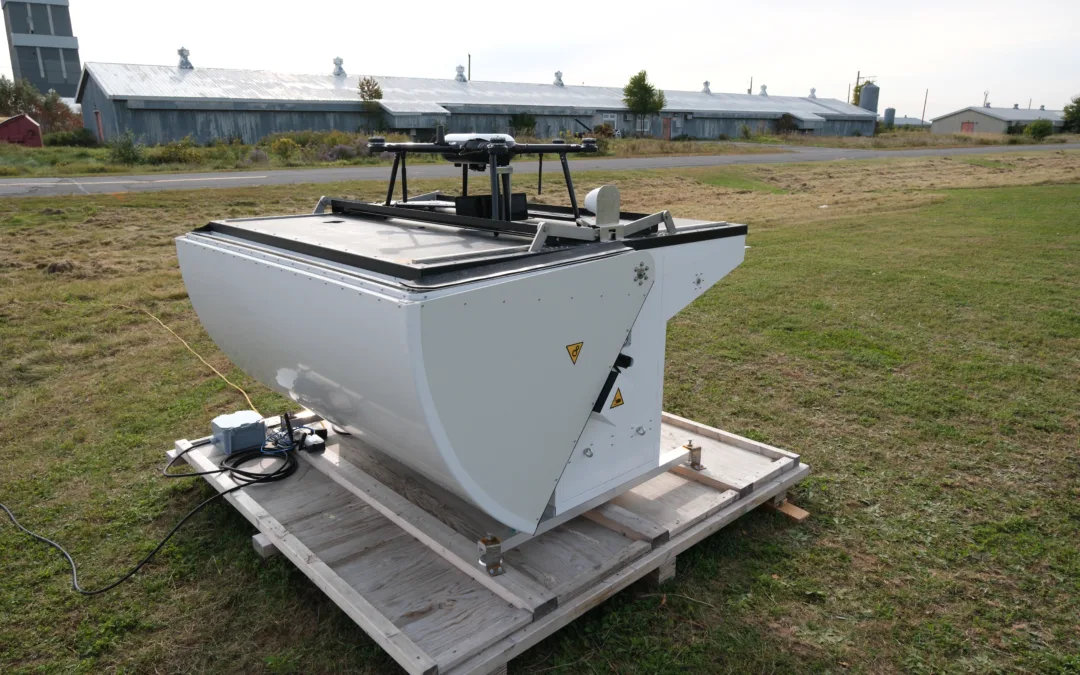By Scott Simmie
A new Advisory Circular from Transport Canada is generating a lot of buzz in Canada’s RPAS world.
Although an Advisory Circular is not legislation, they offer guidance and a glimpse of what the regulator is planning for the future.
“Advisory circulars are one of the methods that Transport Canada can use to provide guidance on complying with regulations,” explains Kate Klassen, Training and Regulatory Specialist at InDro Robotics. Klassen is an instructor and pilot of traditional aircraft as well as drones. Her online courses have trained more than 10,000 RPAS pilots in Canada. She has also served as Co-Chair of the Canadian Drone Advisory Committee, or CanaDAC.
“It kind of acts like a preview, foreshadowing in a way the regulations we know are coming later this fall. This one in particular is exciting because of the depth of guidance that they’ve provided,” she says.
Here’s how Transport Canada describes the purpose of the Advisory Circular – entitled Remotely Piloted Aircraft Systems Operational Risk Assessment – in its introduction:
“This Advisory Circular (AC) is provided for information and guidance purposes. It describes an example of an acceptable means, but not the only means, of demonstrating compliance with regulations and standards. This AC on its own does not change, create, amend or permit deviations from regulatory requirements, nor does it establish minimum standards.
“This AC provides information and guidance to manufacturers and operators intending to develop or operate a Remotely Piloted Aircraft System (RPAS) for operations in accordance with the requirements of Part IX, Subpart 3 of the Canadian Aviation Regulations (CARs).”
The document itself is 131 pages, and a lot of it is dense and laden with acronyms. But for operators planning complex operations down the road – including the potential of flying BVLOS at night – the highly detailed guidance offered in the document is a gold mine. It goes into extraordinarily fine detail about carrying out Risk Assessment in a variety of scenarios.
Below: Screengrab from InDro research into urban wind tunnels being carried out for the National Research Council. This was a highly complex operation involving a heavier drone in a dense urban setting and required a Special Flight Operations Certificate. The new Advisory Circular helps spell out precisely what TC is looking for from operators to ensure safe operations in multiple scenarios

RISK ASSESSMENT AND SFOCs
Back in the early days of drones, pretty much every flight required special permission – an SFOC – from Transport Canada. As drone technology and reliability/robustness improved and the regulator collaborated with the industry, detailed regulations for RPAS were first issued in 2019.
That change meant what we could generally term as routine, low-risk flights with drones weighing up to 25 kilograms could be carried out without an SFOC, providing the operator met all criteria laid out in the Canadian Aviation Regulations, Part IX. That included requirements that the operator have a Basic or Advanced RPAS Certificate to operate small RPAS. TC also established its drone portal, where compliant drones weighing more than 250 grams are registered and assigned a number by the regulator. All of this was, in general, very good news for the RPAS industry.
But for those more complicated operations – generally meaning operations with greater risk – an SFOC was still required to satisfy Transport Canada that the operation could be carried out safely. Specifically, as the AC points out, SFOCs were (and are) still required in these circumstances:
“No person shall conduct any of the following operations using a remotely piloted aircraft system that includes a remotely piloted aircraft having a maximum take-off weight of 250 g (0.55 pounds) or more unless the person complies with the provisions of a special flight operations certificate — RPAS issued by the Minister under section 903.03:
(a) the operation of a system that includes a remotely piloted aircraft having a maximum take-off weight of more than 25 kg (55 pounds);
(b) the operation of a system beyond visual line-of sight, as referred to in subsection 901.11(2);
(c) the operation of a system by a foreign operator or pilot who has been authorized to operate remotely piloted aircraft systems by the foreign state;
(d) the operation of a remotely piloted aircraft at an altitude greater than those referred to in subsection 901.25(1), unless the operation at a greater altitude is authorized under subsection 901.71(2);
(e) the operation of more than five remotely piloted aircraft at a time from a single control station, as referred to in subsection 901.40(2);
(f) the operation of a system at a special aviation event or at an advertised event, as referred to in section 901.41;
(g) the operation of a system when the aircraft is transporting any of the payloads referred to in subsection 901.43(1);
(h) the operation of a remotely piloted aircraft within three nautical miles of an aerodrome operated under the authority of the Minister of National Defence, as referred to in subsection 901.47(3); and
(i) any other operation of a system for which the Minister determines that a special flight operations certificate — RPAS is necessary to ensure aviation safety or the safety of any person.”
“In order to be issued an SFOC – RPAS, an operator must submit an application to the Minister as detailed in CAR 903.02. In particular, CAR 903.02 (p) indicates that in addition to the specific information required by 903.02 (a) through (o), the operator must submit “any other information requested by the Minister pertinent to the safe conduct of the operation”. For certain complex operations, as determined during the application process, an Operational Risk Assessment (ORA), acceptable to the Minister, is one of the items of ‘other information’ required in support of an application for an SFOC – RPAS.”
It’s that last paragraph that’s particularly relevant to this Advisory Circular.
COMPLEX PROCESS
The issue, as many operators discovered, was that applying for an SFOC wasn’t a slam-dunk. It’s not uncommon for TC to come back – sometimes more than once – asking for more details or requesting additional steps or precautions. This slowed the approval process, which was frustrating for operators. Some conveyed to regulators that there wasn’t enough clear guidance to ensure operators were meeting TC’s detailed expectations.
“So it made the SFOC application process for those more complex operations challenging as both parties were trying to sort out what the requirements needed to be to keep things safe,” explains Klassen.
The new Advisory Circular spells out, in detail, precisely what Transport Canada is looking for from operators. It contains multiple protocols, including the fine details of carrying out standardized risk assessments, that will be of benefit to all operators – even in cases where an SFOC is not required. Klassen believes the new document is the direct result of discussions between operators and TC. In addition to making complex operations safer, it provides all the fine print to assist operators in getting everything right the first time with SFOC applications.
“This Advisory Circular, I think, is a result of all of the back-and-forths between those RPAS operators who have been pursuing the boundary-pushing applications, and Transport Canada. TC has been able to accumulate all of that guidance in one location so that the process is streamlined.”
We’ll hit on a few highlights – including BVLOS at night – but the document is so thorough and dense that we’ll link so that operators can download and study it themselves. The Advisory Circular is so detailed that it’s not easy to synopsise, as you’ll gather from the following table of contents. (Don’t worry if some of the acronyms are unfamiliar; there’s an extensive glossary):

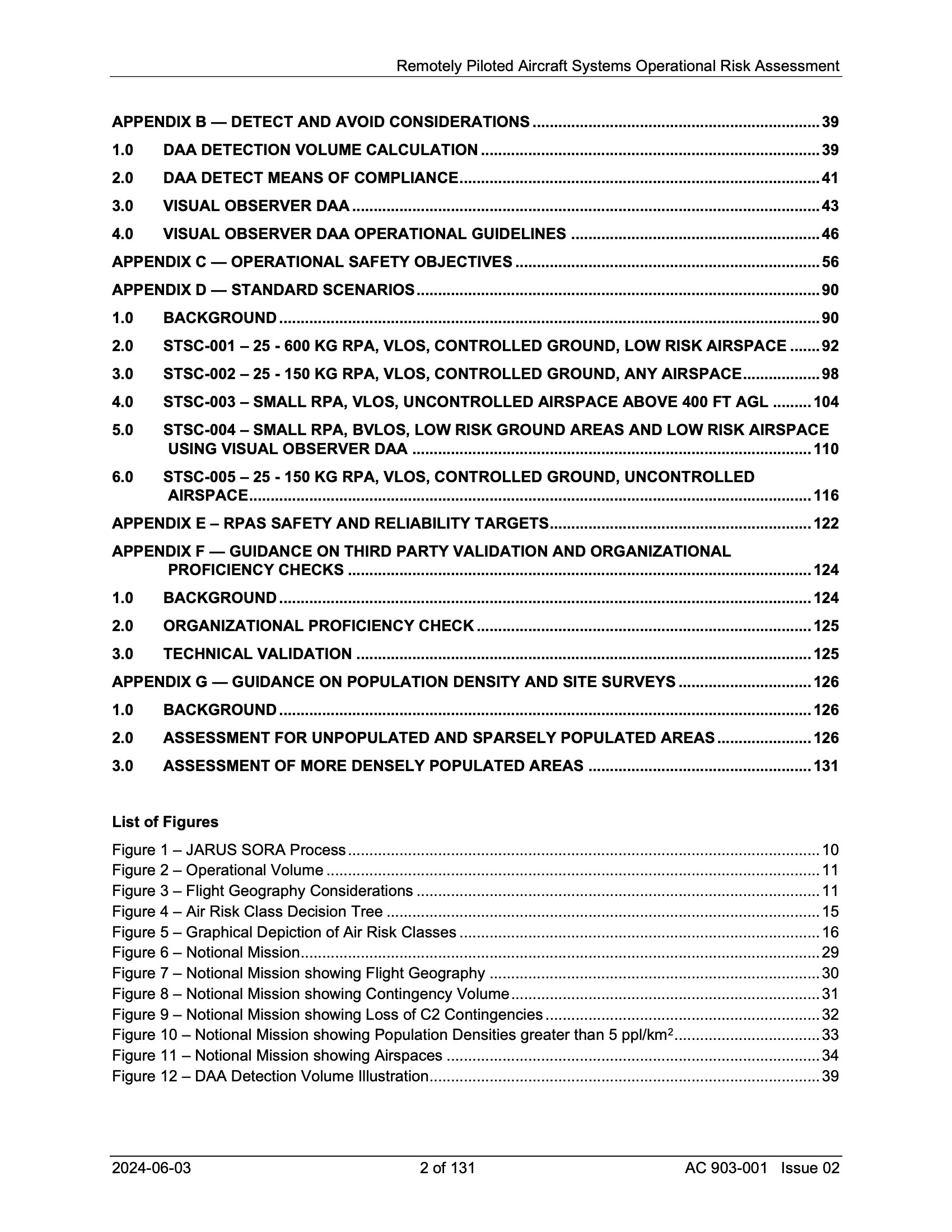
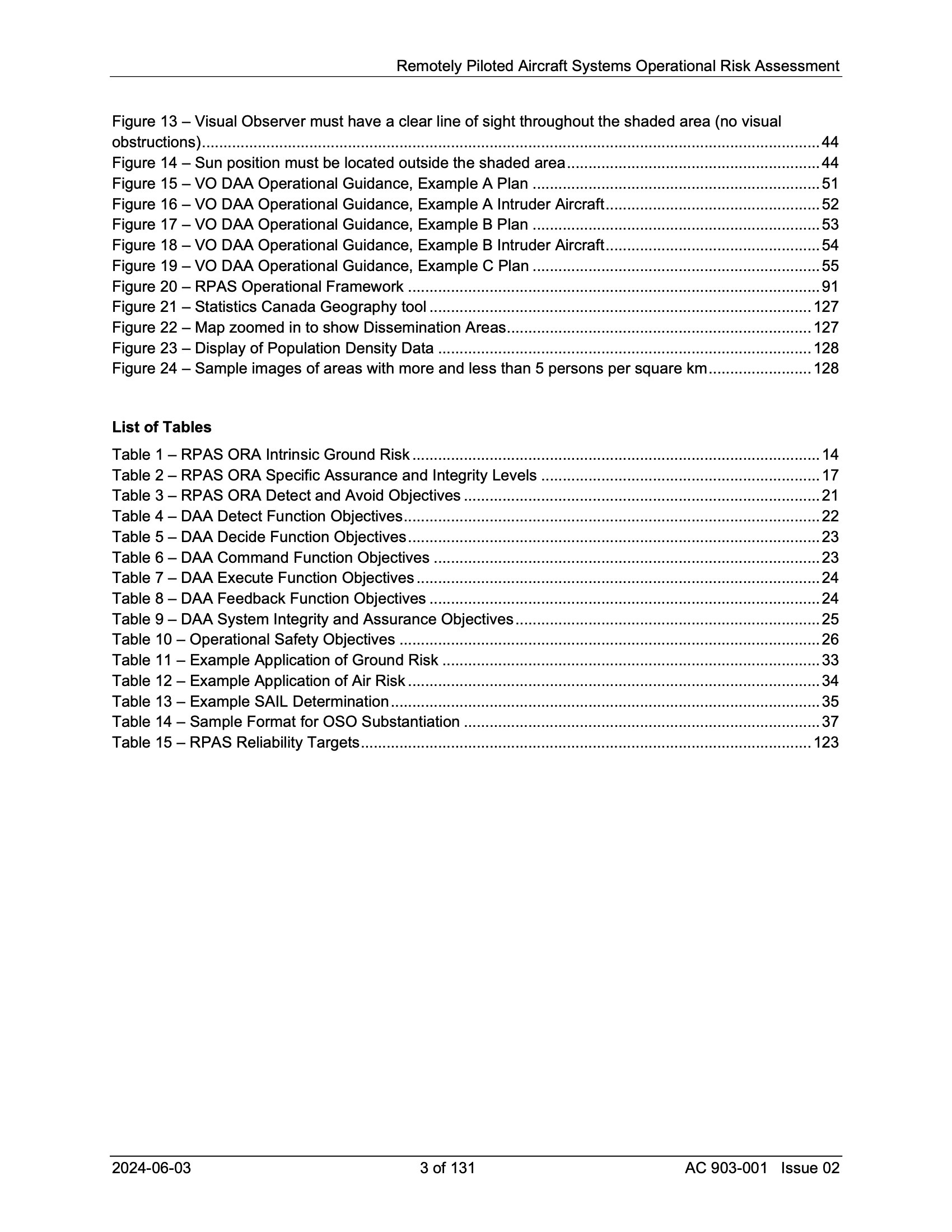
WHAT’S NEW
This is actually a revision to a previously published Advisory Circular. Because it contains so much information, TC thoughtfully provided a round-up of what’s new – and there’s quite a bit that is.
It contains the following changes to definitions:
- Airport / Heliport Environment was renamed Aerodrome Environment and a 3000 ft (915 m) AGL maximum altitude provision was added.
- (ii) The Atypical Airspace infrastructure masking provision was clarified, and a low altitude night provision was added. (We’ve bolded this because it’s kind of a big deal, and we’ll get to it.)
- (iii) Operating Weight definition was added to support changes to ground risk assessment.
In addition, ground risk assessment now relies on the weight of the drone rather than a kinetic energy calculation. Thresholds are now based on the most recently available population density numbers, rather than just a description of the area.
All ground risk scores now assume BVLOS operations; if you are carrying out a VLOS operation that is included as a mitigating factor.
There’s more, of course. But the most attention-grabbing line from above is the provision for low-altitude BVLOS at night. This will obviously require a risk assessment and SFOC, but it’s expected this will be included in legislation anticipated this fall (Canada Gazette 2). And that opens a lot of doors for operators.
“You could fly BVLOS along power lines, transmission lines because there’s not going to be an aircraft within 100 feet vertically of that. You could also carry out deliveries at night, pending airspace,” says Klassen.
It’s also worth noting that Transport Canada had previously indicated that routine, low-risk BVLOS flights will be permitted in the forthcoming regulatory amendments. An additional level of Transport Canada pilot certification will be required for such flights.
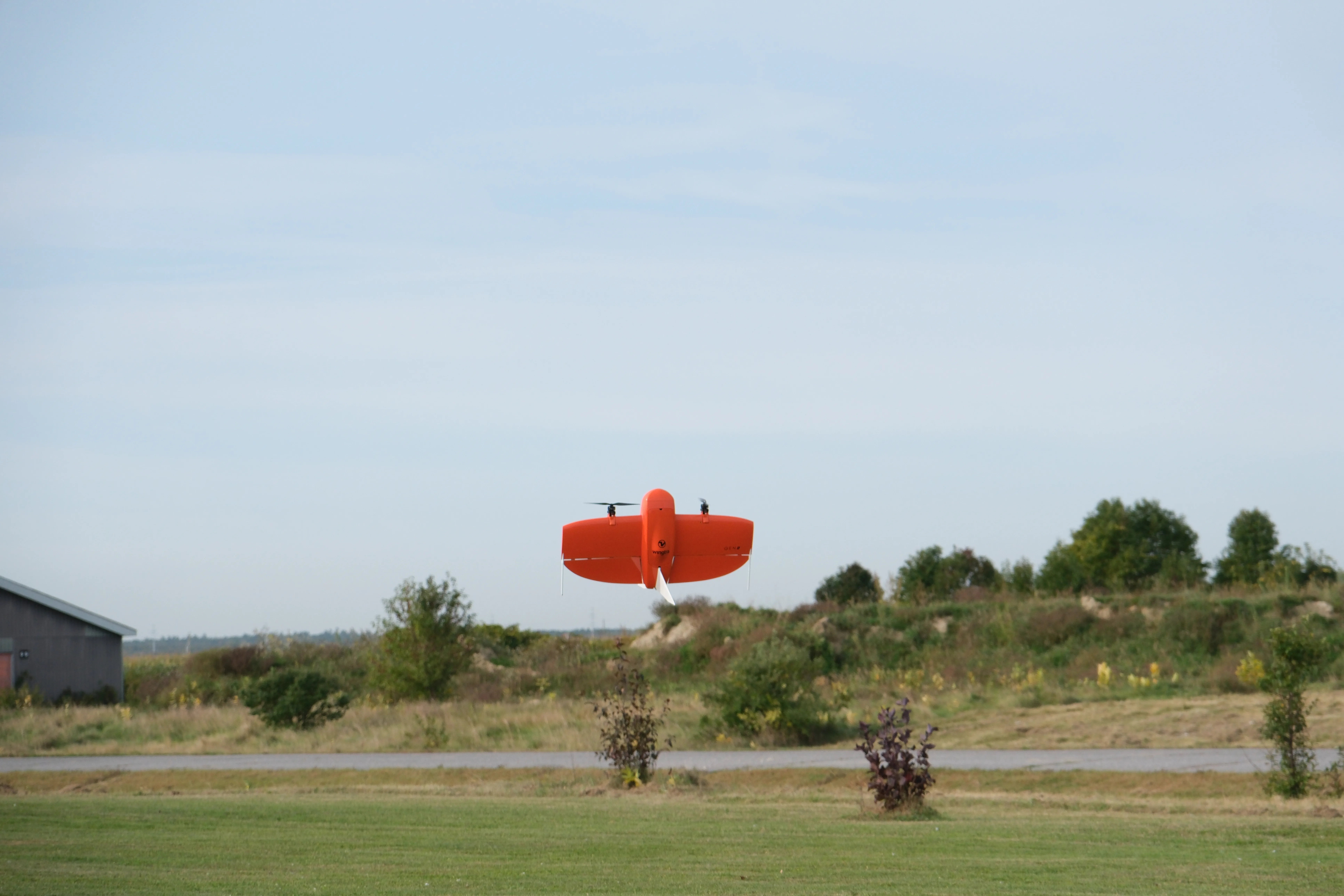
HIGHLIGHTS
When Kate Klassen went through the AC, she was impressed with the extraordinary level of detail. Every step of risk assessment and mitigation is thoroughly described, with examples in the appendices.
Many operators will be familiar with risk assessment tools. But there will also be many, particularly those who currently carry out very basic, non-complex operations, who might know the acronyms but little beyond them. This is very much a “how-to” document.
An Operational Risk Assessment (ORA) is a very methodical process – once you know the method. And here, TC outlines the specific steps laid out by the JARUS (Joint Authorities for Rulemaking on Unmanned Systems) SORA (Specific Operations Risk Assessment) process. (There are some minor tweaks here, which are explained, to optimize this for the Canadian environment.)
The AC walks you through every step of the process, and includes graphics. The document takes a much deeper dive than this overview, with each phase of risk assessment explored in detail. This, however, gives you a glimpse:
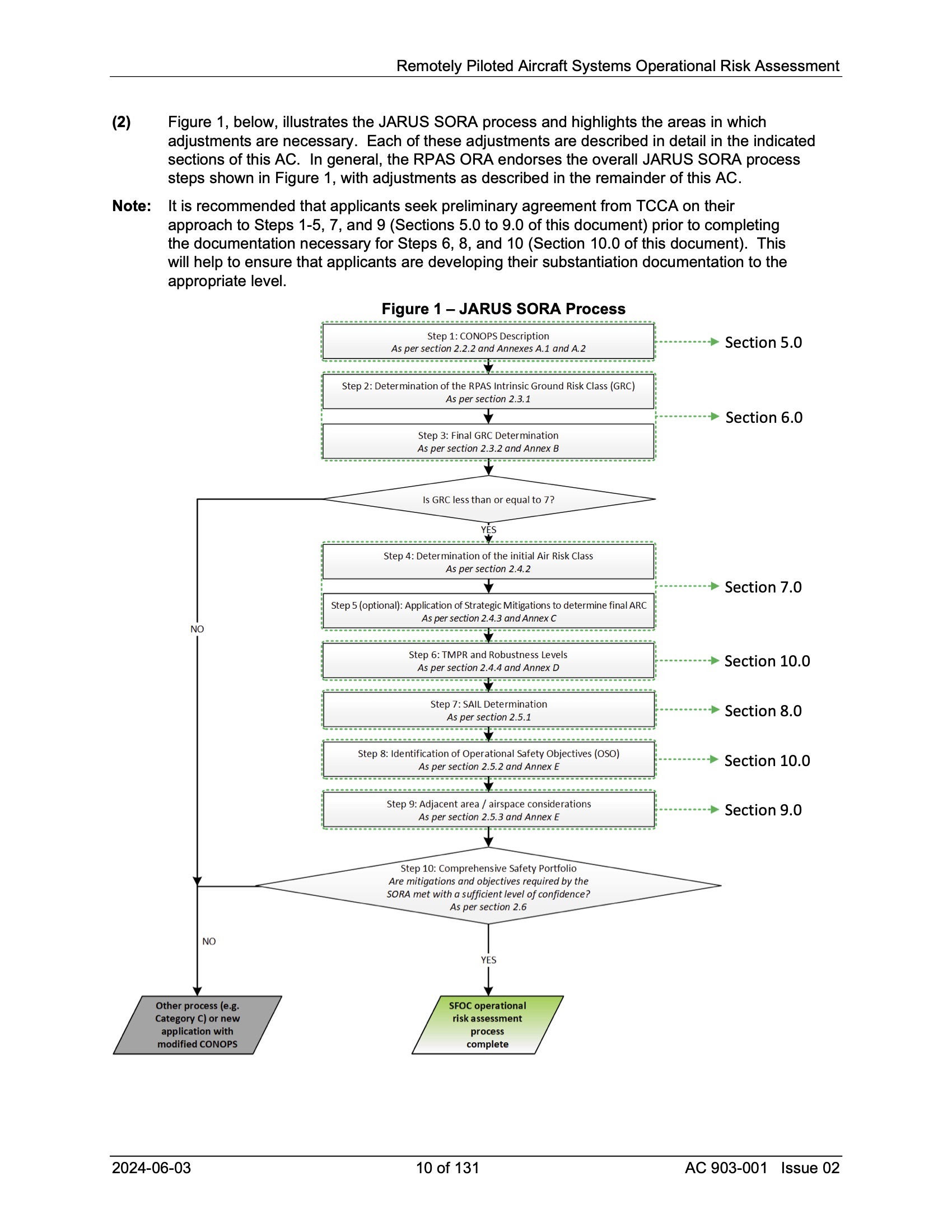
OPERATIONAL VOLUME
The document also defines something critical for any risk assessment – what it calls the “Operational Volume.” This involves calculating boundaries beyond the planned flight operations for safety/mitigation/contingency purposes.
Here’s how the Circular defines it:
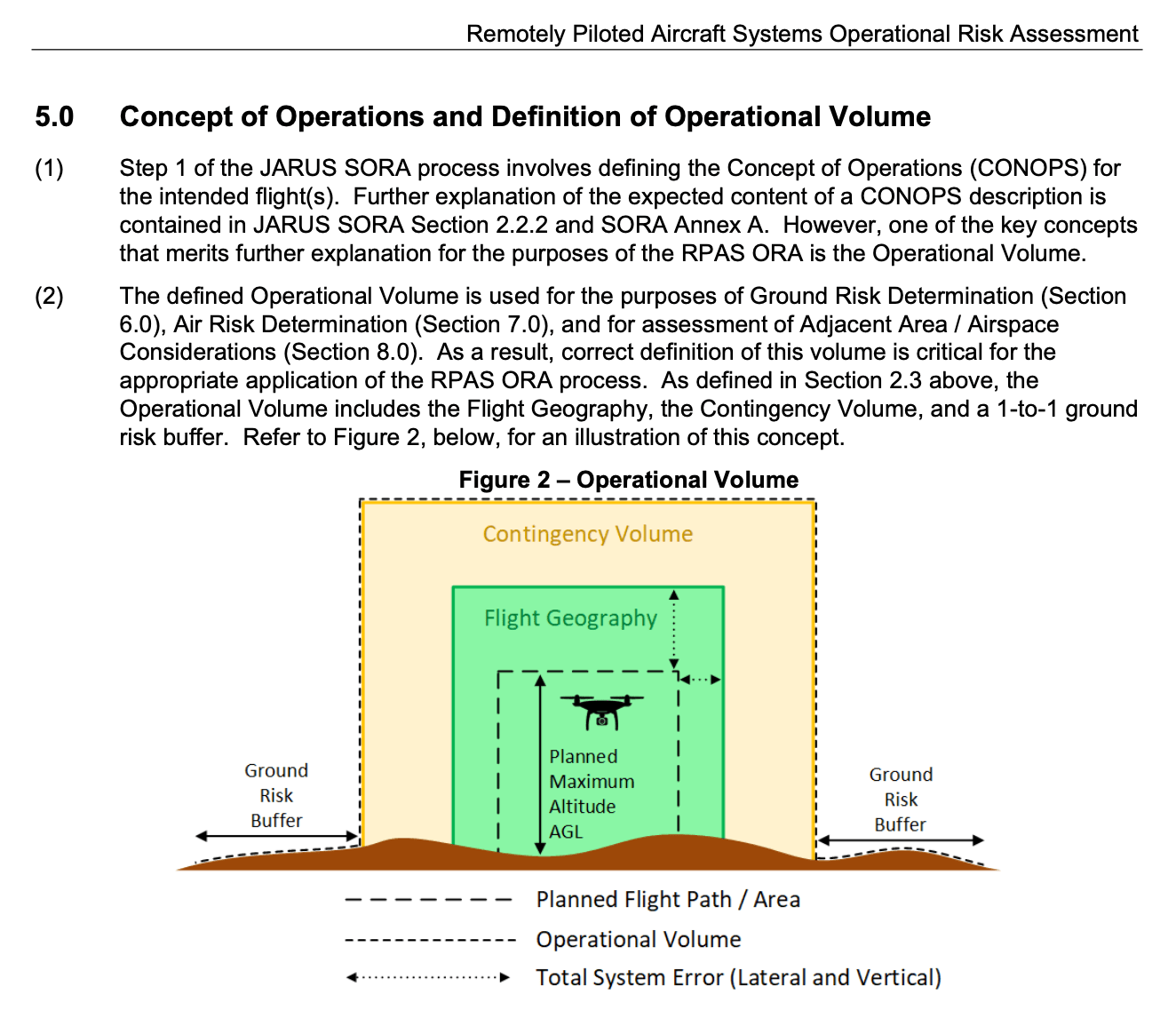
“ATYPICAL AIRSPACE”
One of the things that caught Klassen’s keen eye was the definition of Atypical Airspace. Here’s the wording from the Advisory Circular:
- (i) Restricted Airspace, with authorization from the person specified in the Designated Airspace Handbook TP1820 or in a NOTAM.
- (ii) Northern Domestic Airspace as defined in the Designated Airspace Handbook, outside an Aerodrome Environment, at a maximum altitude of 400 ft (122 m) AGL.
- (iii) Within 100 feet (30 m) above and within 200 feet (61 m) horizontally from any building or structure which stands out vertically beyond the adjacent surface of surrounding terrain with sufficient size and shape to be noticeable to the pilot of a traditional aircraft in flight.
- (iv) Within the hours of legal night, in uncontrolled airspace outside of an Aerodrome Environment, at a maximum altitude of 400 ft (122 m) AGL.
Why is this extension to the definition of Atypical Airspace (AA) exciting? When an operation takes place in AA, the Air Risk Class is automatically assigned as “a” (ARC-a). This lowers the relative SAIL, depending on your Ground Risk Class, and therefore the requirements to meet the operational safety objectives are simpler. It will give you a much easier time applying for and obtaining your SFOC due in major part to the Detect and Avoid options available to you to use.
Below: With adequate lighting (and more safety precautions), operating at night provides some interesting BVLOS opportunities!

INDRO’S TAKE
Transport Canada’s new Advisory Circular is an important, detailed, and well thought-out document. Yet again, TC is attempting to make things easier for professional operators while striking that critical balance of safety – both in the air and on the ground.
“The past decade has seen both tremendous advances in the reliability and safety of drones, and – after some initial resistance in the early days – tremendous willingness on the part of Transport Canada to safely open up new opportunities for the industry at large,” says InDro Robotics CEO Philip Reece.
“The level of detail in the Advisory’s extensive sections on Risk Assessment will be of great benefit to operators – and to the safe expansion of the industry into other use-cases, including BVLOS flights at night. We commend those at Transport Canada for both the vision and thought put into this document, and look forward to the new regulatory changes.”
You can download the Advisory Circular here.

